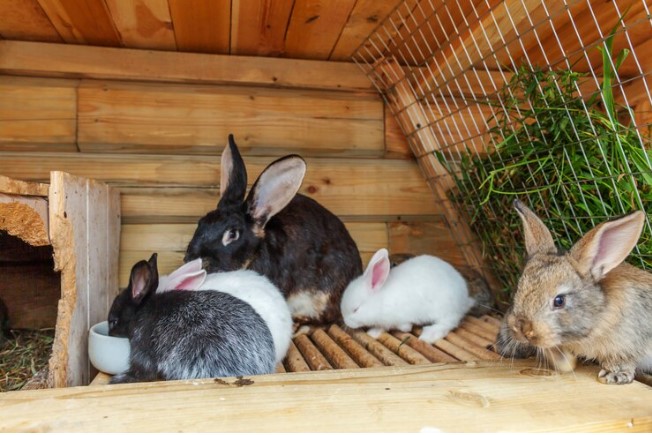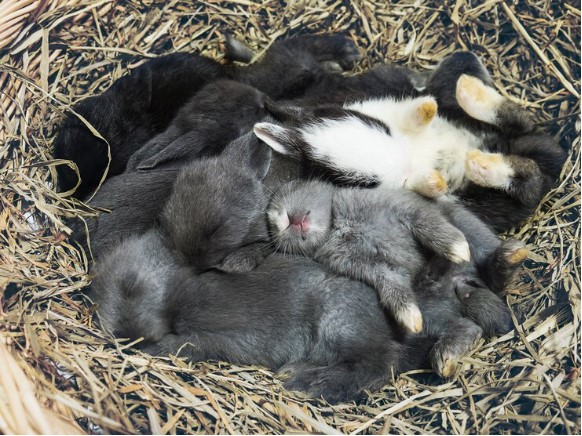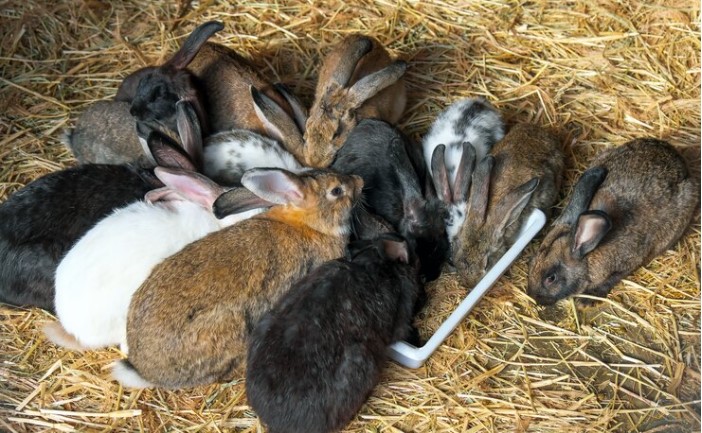From meat and skin to urine, the rabbit-rearing business sells almost everything, maximizing your profits. This makes rabbit farming in Kenya a lucrative venture when practised right.
Rabbit farming in Kenya is a profitable venture that requires little capital to start, unlike most animal-rearing businesses. Once your rabbits mature, you can sell them for between Kshs 2,000 and Kshs 3,000.
Rabbits are a great source of protein compared to pork, turkey, and chicken. Moreover, unlike other livestock, they have less fat, making them a healthier option.
In this exhaustive guide, you’ll learn;
- The benefits of rabbit farming in Kenya
- The requirements of rabbit farming
- Tips to run a profitable rabbit farming in Kenya

Let’s delve in!
Why Invest in Rabbit Farming in Kenya?
With so many livestock-keeping options, you’re perhaps wondering why you should rear rabbits instead of pigs or poultry. Here are some of the reasons why you should invest in rabbit farming in Kenya.

- Low Capital Requirement: Starting a rabbit farm requires little capital to acquire young ones, construct housing, and feed the colony.
- Highly Profitable: When it comes to rabbit rearing, nothing goes to waste; you can sell the skin, meat, and urine. Urine is believed to be a highly nutritious type of fertilizer by farmers, especially in rural areas thus it’s in high demand.
- Short Maturity Period: The maturity period for a rabbit is between 2 to 6 months. Like broiler chickens, they gain weight and size fast and can be slaughtered between 4 and 5 months.
- Less Gestation Period: Rabbits have a shorter gestation period of 28 to 31 days. A female rabbit or doe can give birth every two months to between 2 and 8 bunnies.
- High Food-to-Meat Conversion Rate: Rabbits convert food to meat faster than the rest of the livestock.
- Low Feeding Cost: Livestock such as pigs and enhanced chicken depend on commercial feed. However, rabbits can survive on little commercial feed combined with kitchen waste, plant leaves, and grasses. This helps you reduce the feeding cost, maximizing your returns.
- Tasty and Nutritious Meat: Rabbit meat is delicious and is a nutrient-dense food type. It’s also easily digestible across all age groups, making it suitable for most meat lovers.
Requirements for Rabbit Farming In Kenya
Housing

Although rabbits can be reared on the ground, raising their cages proves to be extremely helpful. How?
You can effortlessly clean the cages as the waste passes through the wire mesh. In addition, you can improvise a method for collecting urine to sell later as it’s in high demand.
Again, rabbits thrive and grow best when allowed to move freely. So, constructing a small house limits their space, resulting in damaged cages or overgrooming.
Proper rabbit housing should incorporate the following:
- Good lighting
- Proper ventilation
- Effective heating
- Cooling systems
You should ensure the colony has 12 hours of light and darkness throughout the year for optimal development.
Besides adhering to the housing size, you must build numerous cages to ensure no inbreeding. When a doe gives birth, you will seclude it into one cage with its bunnies. This significant separation fosters your rabbits’ healthy growth and development.
Rabbit Breeding

Before you start rearing rabbits, you should acquire the necessary breeding knowledge and skills. You should also understand the different breed requirements for easy rabbit production.
Some of the popular breeds in Kenya include:
- California White
- New Zealand White
- Flemish Giant
To optimize the production, you can leverage the short gestation period and influence the does to reproduce 6 times annually. This will give you approximately 50 bunnies per rabbit.
To induce mating, keep the buck and doe together in one cage and later separate into different hutches.
Feeding
Proper feeding is essential in any livestock rearing, whether for subsistence or commercial purposes. So, how do you ensure your rabbits are well-fed?
Typically, rabbits should be fed twice a day and, more so, provide them with much food in the evening as they are nocturnal. This means they tend to be active and eat much at night.
In rabbit rearing, you can apply these two nutrition types:
- Hay and grains diet
- Pre-balanced pellet rations
Usually, the pre-balanced contains all the nutritional compounds necessary for proper rabbit growth. You can feed your colony easily as long as you follow the necessary measurements.
If you decide to feed your colony hay and grain, you must formulate the correct ratios.
Disease Control
Like any other livestock, rabbits are vulnerable to diseases. It is important to note that as a commercial rabbit farmer, illnesses can wipe out your colony or cause significantly decreased production, resulting in losses.
The most common disease in rabbit farming is the respiratory infection caused by Pasturellamultocida. This illness affects your colony’s growth and development, reducing your production. You may notice slow growth or bunnies or minimal weight gain.
Some of the best practices to help you prevent disease outbreaks and infections include the following:
- Maintain a high level of hygiene by disinfecting all cages
- Control peoples’ entry into the rabbit housing as they may be carrying disease-causing agents and introduce them into the rabbitry
- When you identify a sick rabbit, isolate it to observe and treat it. This will help protect the rest of the colony from getting infected.
- Keep accurate records for every rabbit to show their health progression and whether they need special care to keep them healthy.
Record Keeping
You are running a business, so you must monitor the cash flow in and out. This can be quite challenging, especially if you do not have an organized method.
Thanks to record keeping, it helps you note all the developments in all the different areas, including:
- Feed – Types of feed, amount, and cost
- Health – Diseases, the rabbits affected, and the treatments administered with their costs
- Cash Flow – The amount spent on all expenses and the returns within specific periods
- Breeding and Production – The number of pregnant does and the number of bunnies during and post birth, among other breeding practices.
With all these necessary items, you can start your rabbit-rearing business.
Tips for Profitable Rabbit Farming In Kenya

Rabbit farming is a lucrative alternative to livestock farming. To realize massive profits in this venture, you have to implement the following expert tips from successful rabbit farmers.
Tip 1. Enroll for Training
Running a rabbit farm may seem easy, but it has peculiar demands like breeding patterns, hygiene practices, and disease control measures.
As a new rabbit farmer, you will likely implement the wrong procedures, lowering your colony breeding and production level. Hence, training is vital as it equips you with the essential knowledge and skills to boost your rabbits’ productivity.
Training also helps you learn how to handle your rabbits better when ill or to promote mating, among other vital processes.
Tip 2. Identify Suitable Breeds
Which breed performs best in Kenya?
Which breed produces the best meat and skin?
Depending on your rabbit farming goals, you should identify a matching breed that will meet your business objectives. Some of the most popular breeds in the country include New Zealand White, Chinchilla, Californian, and Dutch.
You can also visit local rabbit farmers and find out what’s selling most in your area. This will help you choose the most profitable breed for your farm.
Tip 3. Construct a Good House
An appropriate housing structure provides all the necessary conditions for normal rabbit growth. Some factors you should consider during the construction include ventilation, heating, roaming space, and enclosures for easy separation during quarantine or after giving birth.
Also, remember to construct your cages in the correct positions for easy cleaning and urine collection. The goal is to improve your colony’s productivity and functionality.
Tip 4. Feed Your Rabbit a Balanced Diet
Ever encountered a cow feeding on unconsumable items due to a lack of nutrients?
This can happen in a rabbit farm, too. Typically, when a rabbit is fed a well-balanced diet, it grows in size and gains weight exceptionally.
In contrast, when a rabbit is given feed missing the correct nutrient measurements, its growth and development slow down, not meeting the market standards. Remember to follow the feeding schedule for progressive size and weight gain improvement.
Tip 5. Apply Breeding Management
Mastering the gestation periods for rabbits is not enough to facilitate practical breeding in your colony. You have to learn the best practices for mating and breeding timelines.
You should also control how often every doe and buck mate to ensure you give the does enough time to recuperate. This will help them be more productive and allow you enough time to plan for the new family housing and food.
Tip 6. Invest in The Weaning Process
Weaning entails nurturing a bunny by introducing it to feed to stop it from relying on the mother’s milk. This transition equips the young rabbits with the independence to feed on their own.
Hence, not facilitating this process can affect your rabbits’ health. You can avoid this by learning the best weaning practices and food types to boost your colony’s productivity.
Tip 7. Develop Effective Marketing Strategies
Like other agribusinesses, rabbit farming in Kenya has a market link challenge. As a result, you must be competent to develop a suitable strategy to sell your livestock once they mature.
Start by learning your target audience and their demand statistics. Then, provide offers and quality products to keep them hooked. Again, don’t forget to network with key market players, as they can refer or sell you leads that will optimize your sales.
Also Read:
Frequently Asked Questions
1. How Much Does It Cost To Start A Rabbit Farm in Kenya?
To start a rabbit farm in Kenya, you will need the following:
- A rabbit breeder between Kshs 3,000 to Kshs 6,000
- Housing (for small-scale farmers) Kshs 10,000
- Feed Kshs 3,000 per 50kg bag
2. How Much Is 1 Liter of Rabbit Urine?
Rabbit urine is one of Kenya’s most sought-after fertilizing agents, costing Kshs 650 per litre. So, collecting urine from the entire colony can fetch you massive profits.
3. Where Can I Sell Rabbits In Kenya?
You can sell your rabbits to the Rabbit Republic or Rabbit Breeders Association. These two purchase live rabbits, skin, and fur.
Final Thoughts

Starting rabbit farming in Kenya is an uphill battle. However, with the proper training, you can master and provide your colony with the best conditions, nurturing them to be highly productive.
Want to establish a successful business? Here are more money-making, management, investment, and protection tips to help you achieve your financial goals faster!
Also Read:







